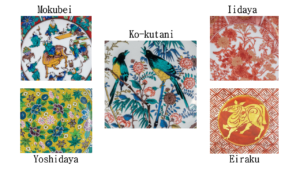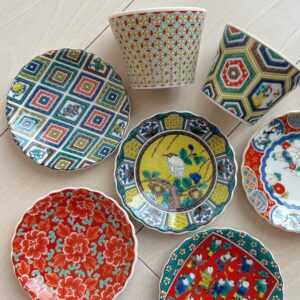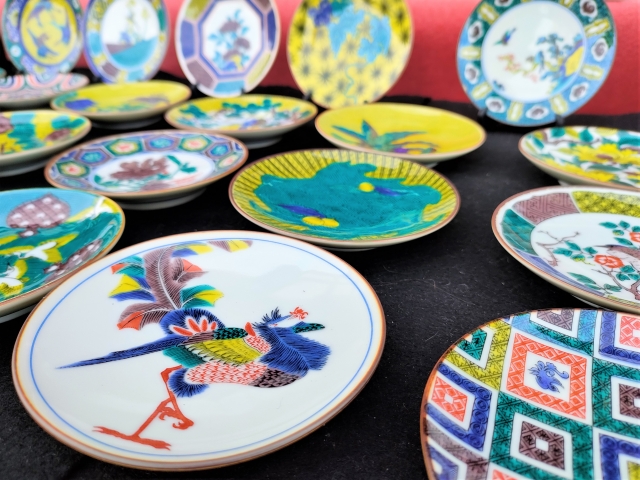Japan is home to numerous traditional crafts that the nation takes pride in sharing with the world.
Each of these crafts is supported by the meticulous techniques of master artisans and embodies Japan’s unique sense of aesthetics. Refined over centuries, they represent the pinnacle of functional yet artistic creations. From lacquerware and ceramics to textiles, Japanese craftsmanship is highly esteemed across various fields. Among these treasures, “Kutani Ware” holds a special place, renowned for its vibrant colors and distinctive designs that continue to captivate admirers both in Japan and around the globe.
Kutani Ware (Kutani-yaki) stands out as one of Japan’s most distinctive types of porcelain. Its history dates back to the early 17th century during the Edo period. The craft originated in Kutani Village, located in present-day Kaga City, Ishikawa Prefecture, under the patronage of the Daishoji Domain, a branch of the Kaga Domain, which took advantage of the region’s abundant ceramic materials. However, the initial production of Kutani Ware came to an abrupt halt within a few decades. The present-day Kutani Ware was revived during the late Edo period, inheriting and evolving its legacy.
This historical backdrop played a crucial role in shaping the unique development and diversity of Kutani Ware.
— “Kutani Gosai” (The Five Kutani Colors)
The defining feature of Kutani Ware lies in its bold and radiant colors. Particularly striking is the use of “Kutani Gosai,” a palette of five vibrant colors—red, yellow, green, purple, and blue—that forms the essence of its aesthetic. These colors, applied using a technique called “overglaze painting,” are fused to the surface of the porcelain through high-temperature firing. Each hue is vivid yet harmoniously balanced, exuding a powerful beauty and depth that leaves a lasting impression. It is often said, “There is no Kutani without overglaze painting,” emphasizing the allure of its extravagant color schemes that mesmerize viewers at first glance.
— Diversity in Patterns and Motifs
Another charm of Kutani Ware lies in its wide variety of patterns and motifs. Traditional designs often feature birds, flowers, landscapes, or mythical figures, but the expressions are remarkably free and creative. Many works blend intricate detail with abstract design, resulting in a unique character that defines Kutani Ware.
Here are some representative styles of traditional Kutani patterns:
Ko-Kutani (Old Kutani)
: Recognized for its bold compositions and vivid colors, Ko-Kutani features classic designs of flora and landscapes. Its use of Kutani Gosai stands out, and its “Aote” (blue style), which excludes red and focuses on blue, yellow, purple, and ultramarine, showcases a distinctive approach where entire surfaces are richly painted.
Mokubei
Inspired by Aoki Mokubei, a celebrated master of Kyo Ware, this mid-Edo period style features landscapes and Chinese-style figures painted on a red background, characterized by detailed and realistic depictions.
Yoshidaya
Representing the revival of Kutani Ware, this style is marked by a predominant use of green, beautifully harmonized with Kutani Gosai. It continues the legacy of Ko-Kutani with intricate designs, often employing green, yellow, purple, and ultramarine to create opulent color-filled compositions.
Eiraku
This luxurious style involves coating the surface entirely in red, upon which gold patterns are painted. Derived from the Kinrande (gold brocade) technique of Kyo Ware, Eiraku designs exude elegance and sophistication, offering a striking contrast to the typical image of Kutani Ware.
Iidaya
Known for its delicate patterns and red-based style, Iidaya is synonymous with the “akae” (red-painted ware) of Kutani. Its intricate hand-painted motifs showcase exceptional elegance and finesse.

In addition to these traditional techniques, modern Kutani artisans and kilns continue to innovate, crafting new designs that reflect contemporary tastes. The ability to honor tradition while embracing evolution ensures that the diversity of Kutani Ware continues to enchant people around the world.
Kutani Ware owes its existence to the meticulous craftsmanship and extraordinary skills of its artisans. Particularly remarkable is the precision of the overglaze painting, where every stroke is carefully calculated, imbuing the motifs with a sense of life and vitality.
The artisans, who undergo years of rigorous training, not only master traditional techniques but also refine their own unique approaches. The intricate process involves conceptualizing the design, sketching it onto the unglazed porcelain, and layering the vibrant Kutani colors with painstaking care. Furthermore, their expertise in anticipating how the glazes will transform during firing is an art in itself.
Each piece of Kutani Ware is not merely a decorative object but a testament to the passion and skill of its creator. Holding one of these works allows you to feel the deep-seated devotion and artistic spirit behind it.
Kutani ware is often associated with its vibrant colors and bold designs, making it a popular choice for decorative or collectible purposes. However, it is also widely used in everyday life as tableware and vases. These pieces seamlessly blend functionality with artistry, adding a touch of elegance and enrichment to daily living. The vivid Kutani Gosai (five traditional colors) play a key role in enhancing the presentation of dishes, elevating the beauty of the food they hold. Japanese cuisine, known for its delicate aesthetic, is a feast not only for the palate but also for the eyes, and these exquisitely crafted utensils are an integral part of that sensory experience.
Holding a piece of Kutani ware in your hands reveals the intricate patterns, bold brushstrokes, and the depth of its glaze. Since each piece is meticulously handcrafted, even those with the same design exhibit subtle differences, giving them unique character. This individuality offers moments of discovery each time you use them, enriching your everyday life with a sense of specialness.
Kutani ware is more than just tableware; it is a work of art infused with the spirit of the artisans who create it. By incorporating these pieces into your daily life, you can transform ordinary moments into extraordinary ones, breathing new life into your dining table and living spaces.

Kutani Ware is a quintessential example of Japanese traditional craftsmanship, celebrated for its dazzling colors, exquisite designs, and meticulous artistry.
As both a decorative art and functional tableware, it continues to inspire awe and admiration among people worldwide. Every piece of Kutani Ware encapsulates centuries of history, cultural heritage, and the heartfelt dedication of its makers. By delving deeper into its allure, one cannot help but be moved by its profound beauty and timeless charm.




コメント